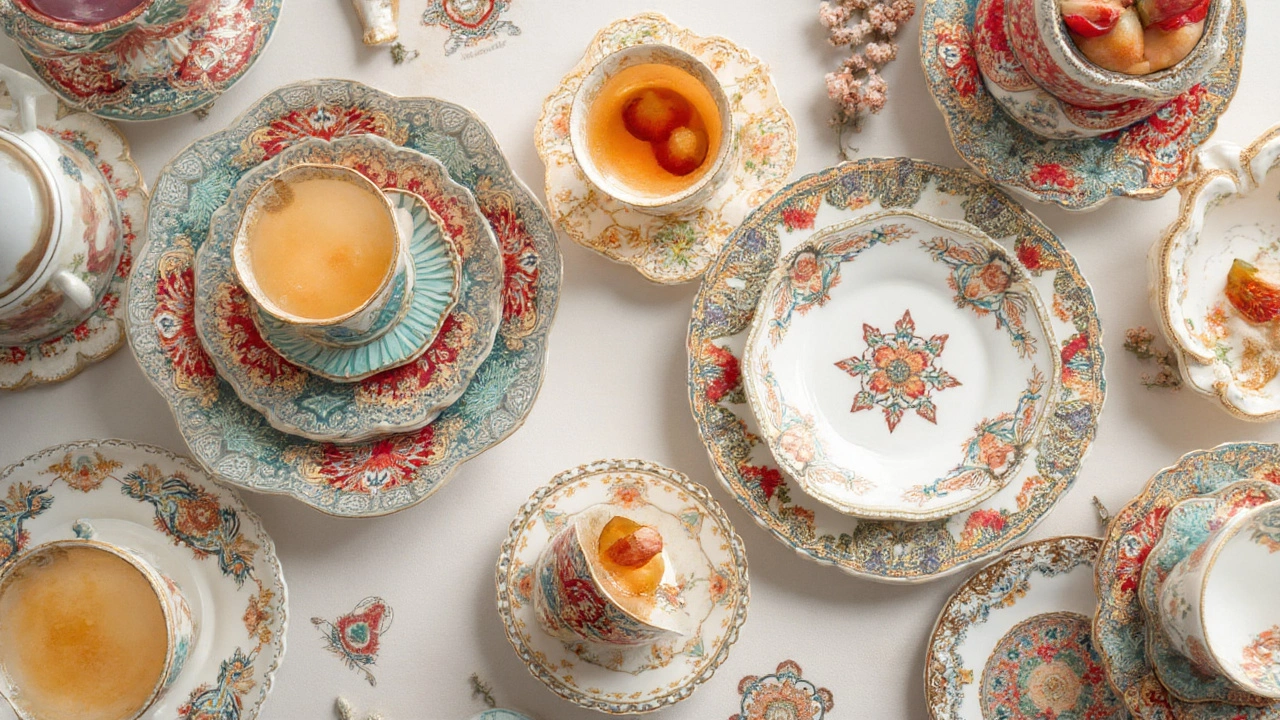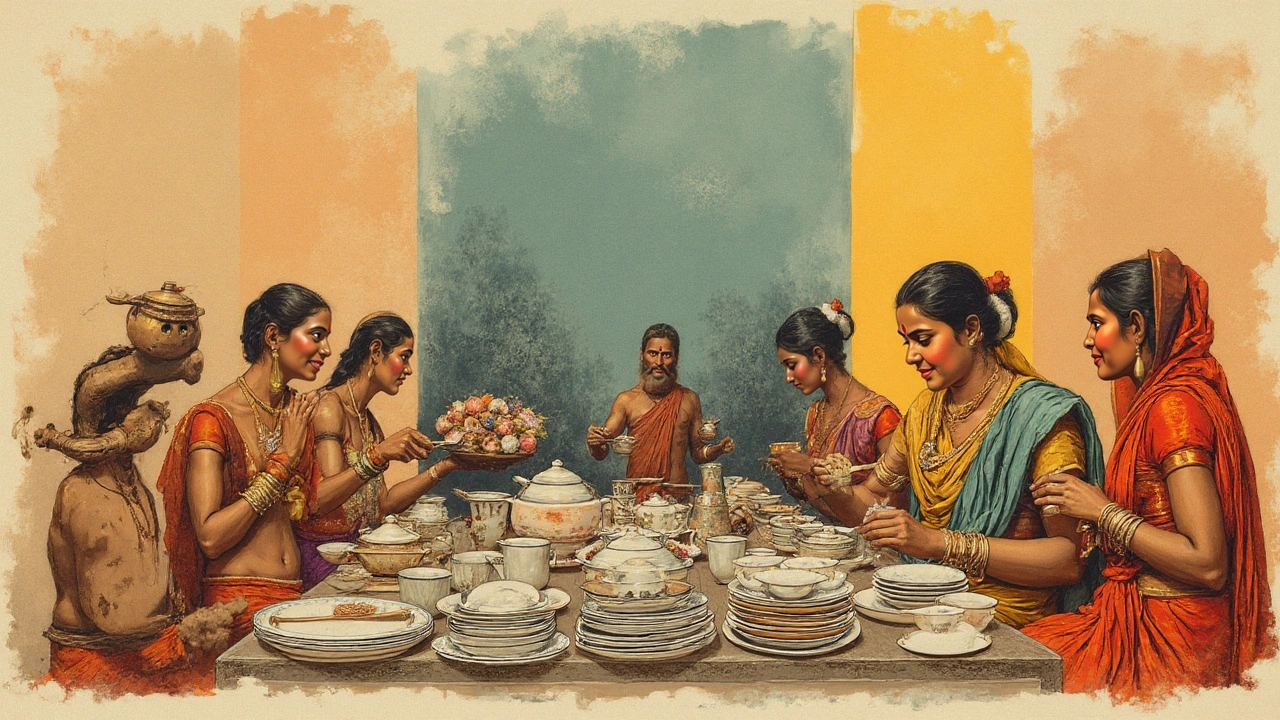Take a look around your kitchen. There’s a good chance there’s a whole jumble of mismatched mugs, plates, and bowls sitting in your cupboards. Some from late-night takeaways, others passed down from your grandmother, maybe a few chipped favorites that you just can’t throw away. The funny thing is, when you want to refer to all these items together, most people trip up. What’s the actual collective name for cups and plates? Does 'dishes' cut it, or is there a fancier word? Spoiler: there is, and it’s not as posh as you might think.
This isn’t some secret code only posh hotels use. The truth is, the right word makes organizing, shopping, and talking about your home easier. Plus, picking the right set could save you cash and make you look like you’ve got your grown-up life together. Ready for some surprising facts? Let’s unravel the labels, myths, and clever tricks behind these kitchen staples you use every single day.
The Collective Name: Tableware, Dinnerware, and More
The main collective name for cups and plates is tableware. Tableware covers the things you use on the table for eating and drinking: plates, cups, saucers, bowls, glasses, and sometimes even cutlery and serving dishes. In shops and catalogs, though, you're likely to spot the words "dinnerware" or "crockery" too. Here’s what’s what:
- Tableware is the broadest term. It means anything involved in setting the table, serving the food, and eating it. So your plates, cups, bowls, trays, even salt shakers are all tableware. Brits tend to use this word for formal and informal meals alike. In the U.S., it sounds a bit more formal, but it’s the right catch-all.
- Dinnerware is more about the actual pieces you eat and drink from – mainly plates, cups, bowls, and sometimes saucers. Think of it as everything you’d lay out for a meal. It doesn’t usually include serving dishes or flatware (like forks and knives). If you walk into a shop looking for plates and cups, asking for dinnerware won’t get you odd looks.
- Crockery is another word you might hear in UK homes. It’s a bit more old-school and refers mostly to ceramic plates, mugs, and bowls – the kind that clang together in your sink. Crockery usually skips glasses and cutlery.
- Drinkware or Glassware is used when you’re just talking about things you drink from (like cups, mugs, and glasses) but doesn’t include plates.
Fancy a quick chart for comparison? Here’s a look at what’s included in each category the next time you’re reorganizing:
| Category | Includes Plates? | Includes Cups/Mugs? | Includes Bowls? | Includes Serving Dishes? | Includes Glasses? |
|---|---|---|---|---|---|
| Tableware | Yes | Yes | Yes | Yes | Yes |
| Dinnerware | Yes | Yes | Yes | Sometimes | No |
| Crockery | Yes | Yes | Yes | No | No |
| Drinkware/Glassware | No | Yes | No | No | Yes |
If you want to sound like you know your stuff at the shops, ask for tableware. If, on the other hand, you find yourself at a yard sale and spot some mugs and platters, calling them 'dishes' or 'dinnerware' works fine too. The terms overlap a lot, but if you ever need to be specific, now you’ve got the terminology up your sleeve.

Curious Origins: How These Words Came to Be
You’d think words for such simple household things would be straightforward. But nope. The terms we use for cups, plates, and their friends are tangled in centuries of history, trade, and habit. Let’s peel back the layers.
The word "tableware" came about in English only in the late 1800s, which is pretty recent. Before that, most British families simply used "dishes" or "crockery"—practical, no-nonsense words. "Crockery" comes from "crock," which literally means a pot made of fired clay. Makes sense—ceramic everything filled the cupboards of Victorian England.
But as factories and railways popped up, importing and exporting wares from far-off places like China (the country) became possible. Suddenly, dishes and cups weren’t just clunky pottery. Fine "porcelain" from Asia inspired fancier phrases, like "china" (yep, that’s why you say your poshest plates are 'the good china').
"Dinnerware" was coined in America during the 20th century as table settings grew more standardised and people started caring about what matched. Catalogs and supermarkets spread the term too, making it the go-to label for boxed sets. Yet if you walk into an old Oxfordshire pub or a granny’s kitchen, you’ll probably still hear "crockery" more than anything else. "Drinkware" and "glassware" got their own spotlight as British pubs and tea rooms made collecting mugs and special glass sets a bit of an obsession.
An interesting tidbit: in some old British and Irish folk stories, dishes and cups had names of their own, handed down just like favorite family pets. There are even museums (like the Pottery Museum in Stoke-on-Trent) where you can see centuries-old cups and plates that tell the story of the everyday British home.
Language keeps evolving. Tableware terms keep changing, not just by geography, but by class, fashion, and trends. For example, post-pandemic, 'sustainable tableware' and 'biodegradable dinnerware' hit the headlines, and new words slip into our dictionaries all the time. Some shops now sell 'reusable partyware'—which is just cups and plates, but more fun and a bit better for the planet.
Knowing the history doesn’t just make you sound clever around the kitchen table. It also helps when you want to shop for a new set or explain to your own kids what those plates at the top of the cupboard are actually called.

Tableware Today: Choosing, Using, and Maintaining Your Set
Walk down the tableware aisle in any big department store and you might feel overwhelmed. Rows and rows of porcelain, glass, wood, bamboo, and plastic. Sets and singles. Posh patterns, cheerful colors, basic white. There’s never been a time with so many choices—and so many ways to get it wrong (or right) for your home.
You don’t need to spend a fortune to get a good looking, practical set of tableware. Here are a few tips I’ve learned from Oxford’s charity shops, dinner parties, and endless student house shares:
- Think about everyday function first. There’s no shame in buying a set of white plates and mugs that can handle the dishwasher, microwave, and even the occasional tumble onto the kitchen tile. If you don’t fuss over matching sets, you can gradually build a collection that suits your habits and tastes.
- Material matters. For daily use, stoneware and porcelain are durable and resist chipping. Bone china is lighter and more elegant but more fragile—maybe keep it for special occasions. Glass tableware looks sleek but can get slippery if your hands are wet (especially those wide-rimmed latte mugs).
- Don’t forget size and stackability. If cupboard space is tight (which is pretty much always the case in Oxford), choose plates you can stack and mugs with handles that fit together. Measure your cupboard shelves before splashing out on very wide dishes.
- Mixing is okay. There’s a growing trend—driven by both eco values and playful style—of mixing different patterns, colors, or even shapes for a relaxed, homey vibe. This isn’t just for quirky cafes; it makes replacing broken items simpler too.
- Don’t rule out secondhand finds. Some of the best cups and plates are hiding in thrift shops or at car boot sales, waiting for a new lease on life. Vintage tableware is often sturdier than some modern options, and every mark tells a story.
One thing to keep in mind: bacteria can hide in scratches and chips. If a plate or mug is badly dented or cracked, repurpose it as a plant saucer or pencil holder. Safety first.
Let’s talk numbers for a quick reality check. The average UK household replaces over 25 pieces of tableware every 5 years, mostly due to breakage, loss, or upgrades (according to a 2022 study by the British Homeware Association). That’s a lot of plates and cups lost to kitchen mishaps, parties, and mysterious disappearances. Buying durable tableware and resisting impulse buys can save you cash over time.
Surprisingly, the type of tableware you use can affect how your food and drink actually tastes. Ceramic and glass don’t add flavor (good for tea and coffee purists), but plastic or metal mugs? They sometimes leave a hint behind. Restaurant chefs know this trick well: that’s why you rarely see meals served on metal plates except at camping grounds or themed diners.
Now, for my best cleaning trick: stained mugs (tea and coffee, I’m looking at you) scrub up like new with a mix of baking soda and a drop of water. For plates, a gentle scour with a non-scratch pad keeps the finish bright. Dishwasher safe is a lifesaver, but avoid stacking too tightly or you’ll get corners that never dry properly.
- Every six months, check for chips and cracks. Bin the ones that could cut you or leach bacteria.
- If you’re buying online, always double check size dimensions. Nothing worse than a soup bowl that barely fits an egg cup.
- And yes, it’s totally fine to eat from mismatched tableware. Some of the best meals I’ve had have been off random plates, surrounded by good company.
So, next time you open your cupboard to grab a cup or plate, you can tell anyone who asks that you’re reaching for your trusty tableware. Doesn’t matter if it’s bone china or a chipped mug from the university fresher’s fair. Tableware is the right word—simple, useful, and proof that day-to-day life is packed with tiny bits of tradition.
